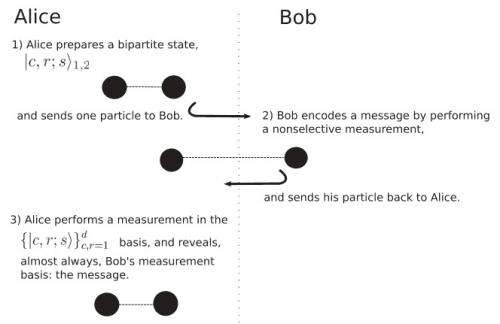August 27, 2013 feature
Quantum measurement carries information even when the measurement outcome is unread

(Phys.org) —Some tasks that are impossible in classical systems can be realized in quantum systems. This fact is exemplified by a new protocol that highlights an important difference between classical and quantum measurements. In classical mechanics, performing a measurement without reading the measurement outcome does not carry any information and is therefore equivalent to not performing the measurement at all. But in the new protocol, a quantum measurement that is performed but not read can carry information because the information can be encoded in the choice of the type of measurement that was performed.
The physicists, Amir Kalev at the University of New Mexico in Albuquerque, along with Ady Mann and Michael Revzen at the Technion—Israel Institute of Technology in Haifa, Israel, have published their paper on the unique features of quantum measurements in a recent issue of Physical Review Letters.
When a measurement is performed but not read, it is called "nonselective." The difference between classical nonselective measurements and quantum nonselective measurements is that the latter cause an inevitable disturbance to the measured system. By tracking this disturbance, the physicists here have shown that it can be used to carry and communicate information.
The proposed protocol involves two parties, Alice and Bob. First, Alice prepares two entangled qudits (D-dimensional quantum systems) and sends one to Bob. Bob performs a measurement on his qudit using an instrument with a certain alignment of his choice, does not read the outcome, and then sends the qudit back to Alice. Finally, Alice measures the resulting two-qudit state, which allows her to deduce Bob's choice of measurement. At no point do Alice or Bob read the outcome of Bob's measurement, but the two parties can still use the measurement to communicate information.
The protocol relies on the uniquely quantum features of the system, since performing nonselective measurements on classical systems cannot carry information.
"In this protocol, we use a non-selective measurement in different bases (different alignments of the measurement apparatus, if you like) to transmit information," Kalev told Phys.org. "To the best of our knowledge, this protocol is the first protocol which uses the disturbance on the system caused by the measurement in different bases, regardless of the actual outcome (!), for a communication task. It seems that, in classical mechanics, one cannot use a similar protocol for communication since there is no notion of 'different' or 'complementary' bases, and moreover a non-selective measurement on a classical system is equivalent to not making a measurement at all."
As the physicists explain, the protocol suggests a novel way to view quantum measurement as consisting of two stages. The first stage involves performing the measurement, while the second stage involves reading the outcome. In the first stage, the state of the system is mixed (i.e., undetermined), but a particular set of variables associated with the choice of the measurement do have a determined value. In the second stage, when the measurement is read, the state of the system is determined. Classical measurement can be thought of as consisting only of the second stage; the first stage is a uniquely quantum component.
The proposal that nonselective quantum measurements carry information is not only of fundamental interest, but could potentially have applications for information tasks. As the scientists explain, Bob's sending of his qudit to Alice can be viewed as a form of dense coding. Although the protocol in its present form cannot be used for secure communication, the physicists are now investigating whether variations of the protocol might be useful for cryptography applications.
More information: Amir Kalev, et al. "Choice of Measurement as the Signal." PRL 110, 260502 (2013). DOI: 10.1103/PhysRevLett.110.260502
Journal information: Physical Review Letters



















